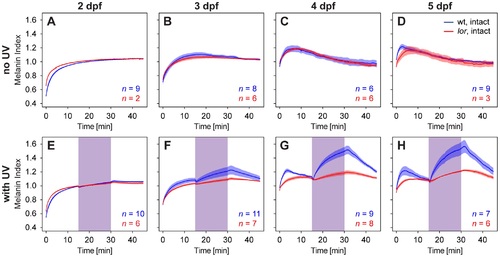Fig. 3
- ID
- ZDB-FIG-141217-18
- Publication
- Mueller et al., 2014 - Sunscreen for fish: co-option of UV light protection for camouflage
- Other Figures
- All Figure Page
- Back to All Figure Page
|
Influence of ocular short wavelength-sensitive (SWS) cone photoreceptors on pigmentation of larval zebrafish. lots-of-rods (lor) mutant zebrafish larvae largely lacking SWS cone photoreceptors show normal melanosome dispersion and aggregation under visible light exposure (A-D). However, the UV-light induced dispersion of melanosomes observed in wildtype fish of 3 dpf and older is strongly reduced (F-H). Values represent means ±1 SEM and are relative to the extent of pigmentation after 30 minutes light adaptation, i.e. a melanin index >1 means the larva is darker compared to the appearance after light adaptation, and vice versa, a value <1 means the larva appears paler compared to the appearance after light adaptation. Data of wildtype larvae is the same as shown in Fig. 2. For ease of comparison, all graphs are drawn at the same scale. Purple shaded areas mark the time interval when the UV light was on. |
| Fish: | |
|---|---|
| Condition: | |
| Observed In: | |
| Stage Range: | Protruding-mouth to Day 5 |

